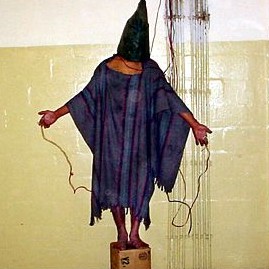The Real Cost of the $10 Billion Loan
GuaranteesBy Marianne Torres
Issue: December, 1991
Sonoma County Free Press
Under cover of the Gulf War, Israel began developing
settlements at breakneck speed in the Gaza Strip and the West
Bank.
This new package is for the ostensible purpose of housing the
same Soviet Jews forced to enter Israel as a result of Israeli
pressure to close all avenues of immigration except to
Israel.
AS THE WORLD WATCHES MADRID IN HOPEFUL ANTICIPATION OF A
RESOLUTION to a nearly one-century-old Middle Eastern conflict,
Israelis and Palestinians face each other across tables large enough
to make a moot point of their respective refusal to shake hands. A
world-class farce in the making, the regional conference (as opposed
to the U.N. sponsored peace conference called for by the Arab world
since 1974, and soon after by much of the rest of the world except
Israel and the US, who have opposed it) is guaranteed by its very
nature to produce nothing but disaster for the Palestinians and a
face-saving way to validate Israel's continued expansion into other
Middle Eastern nations. If you believe the apparent US "tough stand",
we simply suggest you watch what the Baker/Bush does, not what he
says.
Under cover of the Gulf War, Israel began developing settlements
at breakneck speed in the Gaza Strip and the West Bank. As per an
earlier agreement with the US made in order to receive a special $5.6
billion combined military and economic aid package for 1991, Israel
waited until September to demand $10 billion in loan guarantees, to
be implemented in $2 billion installments each year for the next fove
years.
CREATING "FACTS ON THE GROUND"
This new package is for the ostensible purpose of housing the same
Soviet Jews forced to enter Israel as a result of Israeli pressure to
close all avenues of immigration except to Israel. As a rule however,
these immigrants are not being settled in Israel. They are being
settled into the West Bank (including East Jerusalem) and Gaza to
"create facts"&emdash; to make a land-for-peace settlement
politically and physically impossible. The Israeli government has
already built the loan funds into its 1992 budget to free up funds
for increased defense expenditures and even more Jewish settlements
in the Occupied Territories.
The loan guarantees allow Israel to raise money through loans or
bonds on the promise that it will repay investors/lenders the
original amount plus interest over the life of the loan or bond,
usually 30 years. In the very likely event that Israel defaults on
any of the US-backed loans, the US is responsible for the original
loan/bond cost plus interest.
Without the guarantees, it is unlikely that Israel would be able
to secure $10 billion anywhere (loan guarantees of $5 billion each
from France and Germany are contingent on the guarantee from the US).
Israel's credit rating is consistently scored at the bottom of the
scale, and their short-term debt is so unsafe that, by US law,
money-market funds may not invest more than five percent of their
total assets in it. As for its long-term debt, according to the
Christian Science Monitor, that part of the debt that is not backed
by US pledges receives a "triple-B", the lowest credit rating by
Standard and Poor's investment index.
CHOKING THE AMERICAN TAXPAYER
Supporters of the loan guarantee legislation claim that, unlike the
$5.6 billion in direct US aid given to Israel in 1991, loan
guarantees are free to the US taxpayer. However, based on Israel's
previous housing loan guarantees, the real cost to the American
taxpayers will be $3.1 to $7.1 billion if Israel repays the loans,
and between $112 and $117 billion in the very likely event of
default.
The minimum $3 billion is the result of Congress' plan for the US
to pay the service and placement charges normally assumed by a
borrower. US taxpayer costs will skyrocket if, in the absence of
further US grants, Israel defaults. The US would then have to pay all
administrative costs and the original $10 billion, plus interest
charges, which, judging from this year's earlier $400 million loan
guarantee, average 8.6 percent for 30-year loans. The total costs
would range between $112 and $117 billion.
AIPAC ON THE ATTACK
In September, President Bush announced he would ask for a
postponement in the congressional vote, and all hell broke loose on
Capitol Hill. Gearing up for a major battle, over 100 AIPAC
(American-Israel Public Affairs Committee, Israel's lobbying agency
in the US) and other pro-Israel lobbyists descended on Capitol Hill
that week, hoping to exact payback from the Congress they have paid
so dearly and threatened so effectively.
For the first time in years it appeared The Lobby may not get its
way so easily. In the face of worsening recession, deepening
homelessness, school systems in shambles, with cities and states
facing bankruptcy, combined with Israel's obvious unwillingness to
join even a pretense of peace talks, the American public simply did
not appear to be ready for this giveaway, and many of their
Congressional representatives were unwilling to risk the anger back
home.
Publicly embarrassed, and as "peace talks" loomed threateningly,
the lobbyists returned home to regroup. There is talk now that Israel
may even withdraw its demand for the guarantee for this year and
return next year to try again. AIPAC seldom engages in battles it
might not win, although those are few and far between.
The loan guarantees Israel wants represent an additional $2
billion in financial capacity over and above the "normal" economic
and military grants that Israel expects the US government to provide
in 1992. These loan guarantees involve the full faith and credit of
the US government. As a result, they will probably carry a lower
interest rate than bonds sold by American state and local
governments. Israel will have a place in American capital markets
superior to that of American states and cities. Because of the US
government-provided preference, Israel will pay one to two percent
less for its loans than will American states and municipalities.
As they say on the Hill, "The US will not need to figure out which
critical domestic program - housing, job training, education -
actually deserves all or part of the $10 billion. One simple loan
guarantee to Israel eliminates those tough decisions".
***
Author's note, 1997—Need anyone even ask
whether the loan guarantees were granted? Surely you
jest! M.T.
|


































